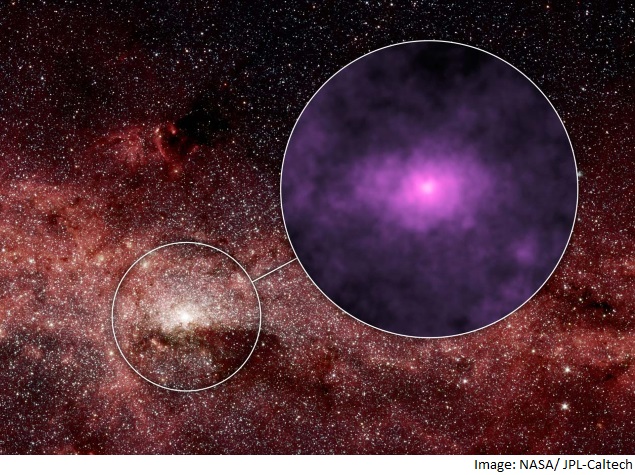- Home
- Science
- Science News
- Nasa Telescope Captures Possible 'Screams' From Zombie Stars
Nasa Telescope Captures Possible 'Screams' From Zombie Stars

These could be the "howls" of dead stars as they feed on stellar companions.
"We can see a completely new component of the centre of our galaxy with NuSTAR's images," said Kerstin Perez from the Columbia University in New York.
The centre of our Milky Way galaxy is bustling with young and old stars, smaller black holes and other varieties of stellar corpses all swarming around a supermassive black hole called Sagittarius A.
NuSTAR, launched into space in 2012, is the first telescope capable of capturing crisp images of this frenzied region in high-energy X-rays.
The new images show a region around the supermassive black hole about 40 light-years across.
Astronomers were surprised by the pictures which reveal an unexpected haze of high-energy X-rays dominating the usual stellar activity, and had four theories to possibly explain them. Three of these are related to different types of 'stellar corpses' or dead stars.
Unlike stars like our Sun, some collapsed dead stars that belong to stellar pairs or binaries can siphon matter from their companions. This zombie-like feeding process differs depending on the nature of the normal star, but the result may be an eruption of X-rays.
According to scientists, a type of stellar zombie called a pulsar could be at work. Pulsars are the collapsed remains of stars that exploded in supernova blasts.
They can spin extremely fast. As they spin, the beams sweep across the sky, sometimes intercepting the Earth, like lighthouse beacons.
"We may be witnessing the beacons of a hitherto hidden population of pulsars in the galactic centre," added study co-author Fiona Harrison from the California Institute of Technology.
Alternatively, the high-energy X-rays could be caused by white dwarfs, burned-out remnants of stars not massive to go nova. Our own Sun is destined to become one roughly 5 billion years. White dwarfs can produce higher-energy X-rays than normal. Another theory points to small black holes feeding off companion stars while radiating X-rays in the process. Finally, the high-energy X-rays may be due to cosmic rays originating from the supermassive black hole and interacting with surrounding dense gas.
This new result just reminds us that the galactic centre is a bizarre place, the authors concluded.
The report appeared in the journal Nature.
Written with inputs from IANS
For the latest tech news and reviews, follow Gadgets 360 on X, Facebook, WhatsApp, Threads and Google News. For the latest videos on gadgets and tech, subscribe to our YouTube channel. If you want to know everything about top influencers, follow our in-house Who'sThat360 on Instagram and YouTube.
Related Stories
- Samsung Galaxy Unpacked 2025
- ChatGPT
- Redmi Note 14 Pro+
- iPhone 16
- Apple Vision Pro
- Oneplus 12
- OnePlus Nord CE 3 Lite 5G
- iPhone 13
- Xiaomi 14 Pro
- Oppo Find N3
- Tecno Spark Go (2023)
- Realme V30
- Best Phones Under 25000
- Samsung Galaxy S24 Series
- Cryptocurrency
- iQoo 12
- Samsung Galaxy S24 Ultra
- Giottus
- Samsung Galaxy Z Flip 5
- Apple 'Scary Fast'
- Housefull 5
- GoPro Hero 12 Black Review
- Invincible Season 2
- JioGlass
- HD Ready TV
- Laptop Under 50000
- Smartwatch Under 10000
- Latest Mobile Phones
- Compare Phones
- Redmi Turbo 4
- Vivo Y200+
- Lava Yuva 2 5G
- OnePlus Ace 5
- OnePlus Ace 5 Pro
- Oppo A5 Pro 5G
- Vivo Y29 5G
- Honor Magic 7 RSR Porsche Design
- Asus Zenbook S 14
- MacBook Pro 16-inch (M4 Max, 2024)
- Honor Pad X9 Pro
- Honor Pad V9
- boAt Enigma Gem
- boAt Enigma Daze
- Sony 65 Inches Ultra HD (4K) LED Smart TV (KD-65X74L)
- TCL 55 Inches Ultra HD (4K) LED Smart TV (55C61B)
- Sony PlayStation 5 Pro
- Sony PlayStation 5 Slim Digital Edition
- Blue Star 1.5 Ton 3 Star Inverter Split AC (IC318DNUHC)
- Blue Star 1.5 Ton 3 Star Inverter Split AC (IA318VKU)

















